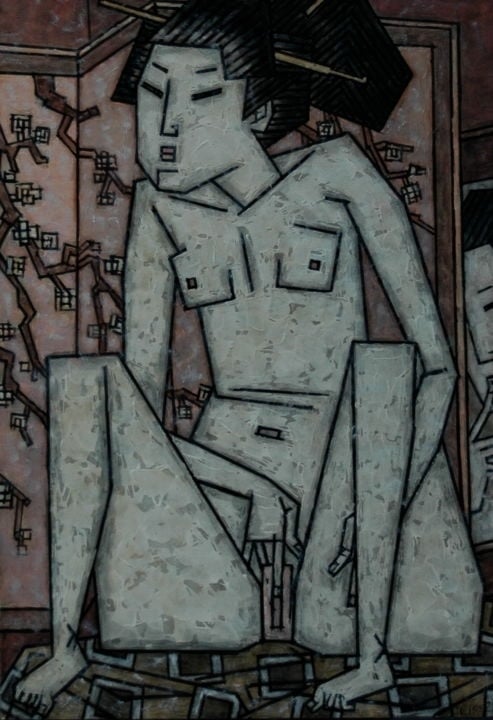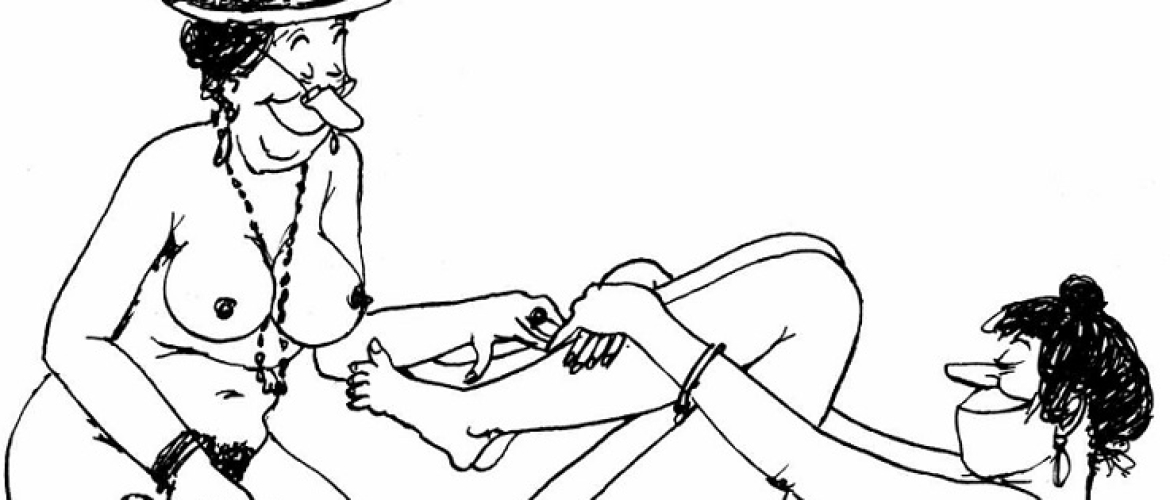
Dmitry Aleksandrovich Trubin (b. 1961) is a Russian painter, sculptor, illustrator, honored artist of the Russian Federation. He was born in Arkhangelsk, where he lives and works at present.

Fig. 1. Self-portrait with the depiction of a geisha in the background
The Career
In 1989, Trubin graduated from the Faculty of Arts at the Moscow Printing University. Since 1991, he is a member of the Union of Russian Artists. Trubin’s illustrated lots of famous books for kids like “Alice’s Adventures in Wonderland,” “The Little Prince,” “The Nutcracker.” He also produced illustrations for classics like Homer’s “Odyssey,” Prevost’s “The Story of the Chevalier des Grieux and Manon Lescaut,” “Candide” by Voltaire, etc.
NIBURT
In 2011, the artist founded his own publishing house, “NIBURT,” that specializes in limited editions of original books. According to the info from artmajeur.com and Wikipedia, works of D. Trubin are in collections of the State Museum of fine arts, Moscow, Russia; the Arkhangelsk Regional Museum of fine arts, private collections in Russia, USA, Canada, UK, France, Germany, Switzerland, Turkey, Norway, Italy, etc.

Fig. 2. The Violinist with Green Hair

Fig. 3. Day Lovers

Fig. 4. Adam and Eve

Fig. 5. Abstract Nude

Fig. 6. Nude
Styles, Shapes, and Subjects
Trubin uses many different manners in his works. He draws rather traditional illustrations for kids as well as cubist landscapes and fauvist portraits and nudes. When it comes to cubism, using this manner, Trubin produces his interpretations (or paraphrases as he calls them) of different works of art, from Christian icons to Japanese erotic prints.

Fig. 7. Naked Girl

Fig. 8. The Little Prince

Fig. 9. Through the Looking-Glass, and What Alice Found There

Fig. 10. Alice’s Adventures in Wonderland
Stained-glass Shunga
The cubist style of Trubin’s paintings, sharp contrasts, and thick lines can weirdly remind you of stained-glass panels of Catholic churches. If someone had built a museum of erotic art in the shape of a temple, these works would have possibly been its’ window panels. Ukiyo-e engravings reworked in this way become more decorative and westernized. The conjugation of contrasts – East and West, modernity and tradition – hooks the mind and imagination of the viewer.

Fig. 11. The Girl Hidden behind the Screen
Hokusai
As Trubin’s series was devoted to the fine art oeuvres, he couldn’t miss an opportunity to pay homage to Hokusai, who is a world-known master of ukiyo-e engraving. Cubist manner removes smooth round lines of the originals, but some things remain unchanged. For instance, the crumpled undergarment, which is the most recognizable feature of Hokusai’s designs, saves its’ sharp angular shape in remakes by Trubin. The geometric kimono patterns seem to look bolder in a cubist context, as well as genitals, which became even more exaggerated.

Fig. 12. Left: “Shunga VIII”. Right: Hokusai, The Gods of Intercourse Vol. 2

Fig. 13. Left: “Shunga” (Erotic paraphrases)-size 39″ x 28″ (2014). Right: “The Gods of Intercourse”, vol. 3.

Fig. 14. Above: “Shunga XII” Below: “Fukujuso” (The Adonis Plant)
Utamaro
Another artist to pay tribute to was Kitagawa Utamaro. Judging by the number of paintings produced after Utamaro, Trubin especially loved to reimagine his shunga pictures and portraits. He appears to succeed in saving the atmosphere of the prints. Despite the roughness of the cubist style, the spectator still can feel peace and pleasure saturating these paintings as much as the originals.

Fig. 15. Left: “Shunga X”. Right: “Utamakura”, 1788

Fig. 16. Left: “Shunga IX” Right: Cover of the German book on Utamaro (I didn’t find the original piece unfortunately). The design comes from Utamaro’s ‘Ehon takara gura (Treasure Room of Love)‘, issued in 1805.

Fig. 17. Above: “Shunga III” Below: “Komachi-biki”

Fig. 18. Left: Trubin’s cubist version of Utamaro. Right: Woman smoking a pipe, 1791

Fig. 19. Trubin’s version of Utamaro’s print. Right: “Beauty with Cloth”

Fig. 20. Left: Trubin’s painting. Right: “Woman in Bedroom on Rainy Night”
Shuncho
Although we haven’t found the exact source of fig. 21, fig. 22, and fig. 23 their coloring is close to benigirai-e or so-called “red hating prints,” in which subdued colors were used. As known, Katsukawa Shuncho produced many designs of this kind. Along with this, the influence of Utamaro can’t be wholly excluded, because this artist often used specific kimono patterns.

Fig. 21. “Shunga IV”

Fig. 21a. Katsukawa Shuncho, ca. 1798 (britishmuseum.org)

Fig. 21b. Shuncho, 1780s (japaneseprints.net)

Fig. 22. “Shunga II”

Fig. 22a. Shuncho/Kiyonaga (theartofjapan.com)

Fig. 23. Trubin’s “Shunga”

Fig. 23a. Shuncho’s print from the series “Erotic Illustrations for the Twelve Months”
Koryusai

Fig. 24. Left: “Shunga V”. Right: Koryusai, 1760s.
Another artist that supposedly influenced Trubin’s cubist interpretations was Isoda Koryusai. In the painting, you can still recognize some features (coloring, head, hair, facial expression) that are specific for shunga prints of the 17th century produced by Koryusai and Harunobu.
Eishi

Fig. 25. Left: Trubin “Girl with a Sake Cup”. Right: Hosoda Eisho (active ca. 1780–1800) Takigawa of the House of the Fan Holding a Sake Cup (Ogiya Takigawa) Color woodblock print: oban tate-e 39.1 x 26 cm; ca. 1794–95 Series: Comparison of Beauties of the Pleasure Quarters (fujiwara-nurie.net)
The Ukiyo-e master Hosoda Eishi, who was a disciple of Utamaro and Kiyonaga, wasn’t ignored by Trubin too. Eishi was a founder of the Hosoda school specializing in bijinga designs. Bijinga was a term used for pictures of beauties. The piece depicting Takigawa of the House of the Fan holding a sake cup (Ogiya Takigawa) became the source for a cubist painting of the Russian artist.
Kunimaro
Two paintings from Trubin’s set were inspired by Utagawa Kunimaro’s “A Treasure Ship Embarking at the Isle of Women (Nyogo no shima takara no irifune).” Possibly, the artist was attracted by some exotic details like the carpet and the chair of queen Chidori.

Fig. 26. Above: Trubin’s version of Kunimaro’s “ foreign carpet” design. Below: Kunimaro’s original

Fig. 27. Above: Trubin’s version. Below: Kunimaro’s original

Fig.28. ‘Games of the Samurai‘ (Saatchiart.com)
All images of Trubin’s paintings are taken from artmajeur.com.
Click HERE for an article that explores the similarities between shunga and the work of the French illustrator Martin van Maële….!!
Do you like these kind of articles that juxtaposes classical shunga and modern art? Leave your reaction in the comment box below…..!!










